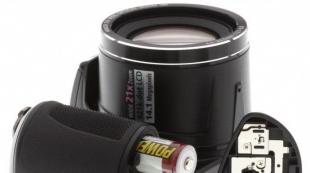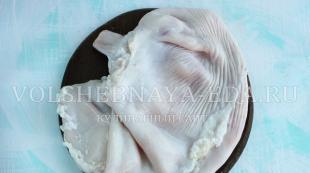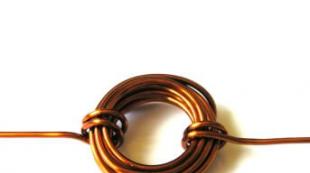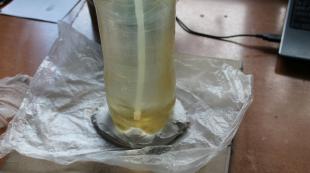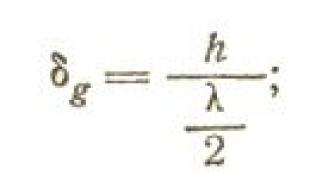A word that begins with a hissing consonant. Consonant sounds of the Russian language (hard-soft, voiced-mute, paired-not paired, hissing, whistling)
1. Read.
In the spring, the rain is crazy, if he wants to, he will wet everything, cry jokingly, deceive with tears, fool everyone and stop.
(I. Ehrenburg)
- What is the name of the rain? Why?
- Find words that have hissing consonants. Say every hissing sound. Name the letter with which it is indicated on the letter.
2. Name the items.
- Say the names of these objects. Listen to the hissing consonant sound in each of the words.
- Which of the hissing consonants in these words are hard and which are soft?
Page for the curious sizzling
sizzling
Some sounds were given an interesting name: hissing. Say the sounds [w], [h "], [u"] one after the other. What do the sounds remind you of? Maybe this is how oil hisses in a frying pan, a kettle boils, dry leaves rustle underfoot, an iron hisses or sparkling water?
The sound [zh] was also called hissing not by chance: first say it loudly, then quieter and quieter - [zhzh-zhzhshsh-sh]. Now say the words hedgehog, already, and again you hear the sound [w] in these words.
(V. Ivanova)
3. Read.
- How do the sounds [w] and [w] sound: hard or soft?
- Write down any phrase. Test yourself. Mark the stress in the words.
The hedgehog has a hedgehog, and the snake has a snake.
Sasha and Mishutka have funny jokes.
4. Read.
- What sounds are taught to pronounce tongue twisters? Say them.
- How do the sounds [u "] and [h"] sound: hard or soft?
- Say any tongue twister slowly at first, then faster and faster. Highlight hissing consonant sounds with your voice.
Two puppies cheek to cheek
pinch the brush in the corner.
Four turtles
four turtles.
5. Read. When do they say so?
- Write down one sentence. Underline the letters in the words that represent the hissing consonants.
Good work lives for two centuries.
Work time, fun hour.
Job
Page for the curious
About the origin of the word
Word pencil came to us from the Turkic language. It consisted of two words: Kara And dash. Word Kara means "black" dash means "stone". Word pencil in this language it was understood as a "black stone", graphite.
6. write a word pencil. Underline in it the letter denoting an unpaired solid hissing consonant.
- What object do we call a word pencil? What is it for? What color do you think the pencil lead used to be? And now? What is simple pencil?
This article is about what are hissing sounds in the alphabet. About how they are pronounced correctly, about their origin.
There are 33 letters in the Russian alphabet. We see letters, but we pronounce and hear sounds. There are 10 vowels, 21 consonants, and the letters b and b have no sounds. But the consonants Zh Sh Ch Shch have a hissing sound and are hissing letters. Ever since elementary school, I remember well the rule about hissing: "zhi-shi" write with "i", "cha-cha" write with "a", "chu-shu" write with "y", it is also useful to remember and know, but This is a topic for another question.)
The hissing sound in the Russian alphabet is given by four consonants: Zh, Sh, Ch, Shch. The letters Zh and Ch are voiced consonants, the other two letters Sh and Shch are deaf. When pronouncing these letters, the lips behave in exactly the same way - they tighten and slightly stretch forward. It will not be possible to pronounce these sounds with closed lips (compare, for example, with the pronunciation of the letter "M" - it can also be "spoken" with closed lips). At the same time, the tip of the tongue is slightly pressed against the palate, leaving a small space in the center of the tongue. It is through this space (or gap) that the air passes, which forms a hissing sound from the pronunciation of these letters. The air is exhaled. When you pronounce the sound "zhzhzhzhzh", the vocal cords are turned on, so this sound is louder.
Pinching consonants - consonants [sh], [zh |, [""], as well as [sh "] [zh"], so called according to the acoustic impression they produce. In other Russian language Sh. s. [sh " ], [zh"], [V] were originally soft: they arose as a result of the first palatalization (see) or as a result of a change in combinations of consonants with /: "chj," sj>$", * gj, "zj, "dj >z\ "kj", "tj>c" . The primordial softness \w "], [w"], [h" \ determined that in the written monuments the letters denoting these consonants were used with the subsequent vowels b, and, as well as l (ed) and y: mouse, husband , sLch; nessshi, you run, clean; didn’t go, zhlti, hour; I write, kozhuh, comfort. that the consonants [and / "], [zh"], [h"] did not have a solid pair and there was no need to differentiate the spelling of vowels after them.
Learning letters
In the history of Russian the language [shg] and [g "] were hardened, and [h" \ was preserved as a soft consonant; hardening Sh. refers to the 14th century: during this period, the writings w and w appear in the monuments, followed by the letter y: live, de-rzhyt, Shyshkina (Dmitry Donskoy's Spiritual Letter, 1389). Modern orthography retains the traditional spellings of letters and and ъ (at the end
nouns wives. gender and some forms of verbs) after w and w: sew, fat, mouse, rye, carry, do not disturb.
Modern long sh. [YG] and [zh "] arose from
Old Russian combinations [w"t"w"], [zh"d"zh"] (ascending to the combinations respectively "stj," skj, *sk and "zdj, *zgj. "zg) as a result of the loss of the explosive element in these combinations in such words as looking for - [ish "t" w "y]> > [ish" y], bream - [l "ssh" t "w" in]> [l "esh" a], yeast - [dr6zh"d"zh"and\>\dr6zh"and], rain -
\d6zh"d"zh"ik]>[d6Ж"ik]. They retain softness in many Russian. dialects and in Staromosk. pronunciation, which formed the basis of the oral form lit. language (see Moscow pronunciation); in other dialects they were hardened, and
sometimes saved as [shh"), [zhdzh"] or [pcs"], [zhd"]. In modern Russian lit. language, there is a tendency to pronounce a solid [zh \: hedgehog], [vbzhy], [v "iZhat"] or a combination of [zhd"]
Nomination "Multimedia technologies in the pedagogical process in preschool educational institutions"
“I do not prefer the sound technique because
that children learn to read and write faster from it;
but because, having successfully achieved its special goal,
this technique at the same time gives independence to the child,
constantly exercises his attention, memory and reason of a child,
and when the book is then opened before him, it is already significantly
prepared to understand what he is reading, and, most importantly,
it is not suppressed, but aroused interest in learning. K.D. Ushinsky
Preparing children for literacy is an extremely important stage in the mental and speech development child. When teaching literacy, it is necessary to form basic concepts in children, such as: “sound”, “vowel”, “consonant”, “hard”, “soft”.
This process is complicated by the fact that the child's thinking in preschool age predominantly visual-figurative, that is, the baby mainly operates with images, not concepts. To solve this problem, when preparing children for literacy, along with various game techniques, I use computer games made independently in Microsoft Power Point, which increase the cognitive activity of children, contribute to the development of mental cognitive processes: perception, attention, memory, different types thinking.
Instructions for the game "Hissing Sounds"
Purpose of the game: to form in children the prerequisites for learning to read and write.
Correction-developing h adachi:
- to fix the correct pronunciation of sounds [w], [g], [h], [u] in words, sentences;
- exercise in the differentiation of sounds [w] - [s], [g] - [s];
- continue to teach children the sound analysis of words;
- develop auditory and visual perception, thinking.
Slide #1 is the title slide.
Slide number 2 - game selection: to select a game, click on its name. It is possible to play through the game sequentially, as well as its individual tasks.
The game "In which word is the sound hidden?" - slides No. 3, 4, 5, 6, 7. Exercise children in choosing words with a given sound. By hyperlinks, the sound is selected, the pronunciation of which must be fixed in words. The choice of words in each task is carried out by clicking on the subject pictures at the top of the slide. If the word is named correctly, the picture turns over, if it is incorrect, it disappears. Sound [w] - bear, cone, cherry. Sound [w] - beetle, blackberry, giraffe. Sound [h] - butterfly, clock, ball. Sound [u] - lizard, puppy, brush.
The game "Where is the sound hidden?" - slides No. 8, 9, 10, 11, 12. Exercise children in determining the place of sound in a word (at the beginning of a word, in the middle and at the end of a word). By hyperlinks, the sound is selected, the position of which must be determined in words. The choice of words in each task is carried out by clicking on the subject pictures at the top of the slide. The selected word is dropped onto the corresponding scheme.
The game "Dress the sounders" - slides No. 13, 14. To consolidate knowledge of the acoustic characteristics of hissing sounds. The child must give a description of each hissing sound, in accordance with this characteristic, choose a hat and shoes for the sound. For example: the sound [w] is a consonant, hard, deaf, he needs to put on a hat and blue shoes.
Game "Toy Store" - slides No. 15, 16, 17. Exercise in the differentiation of sounds [w] - [s]. In the chest with the letter C, you need to put (name) toys, in the names of which we hear the sound [s], and in the chest with the letter Ш - words with sound [w].
Zoo game - slides No. 18, 19, 20. Exercise in the differentiation of sounds [g] - [h]. Place (name) animals in the enclosure with the letter Z, in the names of which we hear the sound [z], and in the enclosure with the letter Z - words with the sound [g].
Fun Train Game - slides No. 21, 22, 23, 24. Develop the concept of "syllable" in children, exercise in dividing words into syllables, determining the number of syllables in a word. Words with one, two and three syllables are determined by hyperlinks - wagons with the numbers 1, 2, 3. The choice of words in each task is carried out by clicking on the subject pictures on the right side of the slide. If the word is named correctly, then the picture moves to the car, if not, it disappears.
Game "Pick up the words" - slides No. 25, 26, 27. Develop the skills of sound analysis of words, differentiation of sounds into vowels, hard and soft consonants. At the bottom of the slide, a sound scheme is offered, to which children must pick up a word, the choice of words is carried out by clicking on the subject pictures at the top of the slide. If the word is chosen correctly, the picture is flipped, if it is wrong, the picture disappears.
Slide number 28 - a list of sources used.
It is no coincidence that hissing consonants got such an interesting name - they really seem to hiss, because they are pronounced in a special way. Our article for grade 2 students tells in detail about them: what groups such sounds are divided into, which ones have features and phonetic characteristics.
What are these sounds and how to pronounce them
Hissing sounds are distinguished from the rest by the acoustic noise that they produce, that is, hissing. You can pronounce them correctly only with the lips open and slightly extended forward, while the teeth are almost closed. Thus, a gap is obtained, passing through which the air hisses. So, a striking example of a hissing consonant sound is the sound [u], which is clearly pronounced in this way, without adding a voice. All four of these sounds are always pronounced on the exhale. At the same time, the sound does not pass from the sides: it is blocked by the tongue pressed against the molars and the hard palate. That is, in order to pronounce the hissing sound correctly, you need to “make” a ladle from the tongue.
We can say that they have a difficult character - it is difficult to pronounce them not only for children, but also for many adults. To learn how to do this correctly, you need to follow not only the setting of the tongue and lips, but also the exhaled air: its jet passes approximately in the middle and should be wide enough. You can check this by raising your hand to your mouth.
If you follow your articulation, you will notice that all hissing sounds are based on one - [w]. So, [g] appears if you add a voice to it, that is, a trembling of the vocal cords. With [u], the middle part of the tongue rises, and with [h], a bow in front of the labiodental fissure is also added to such a rise.
Unpaired or paired?
The science of the Russian language considers unpaired sounds[h] and [u], and [g] and [w] - paired only on one basis. And indeed, since other sounds that have a pair, they cannot be completely combined. However, there are two signs by which they can be combined into groups - this is sonority / deafness and hardness / softness. So, [g] and [w] are only hard sounds, and [h] and [u] are soft. It doesn't matter what vowels come after them. Even if you put a soft sign after the letter denoting a hard hissing, the sound will be pronounced firmly.
As for the division into deaf and voiced, [w], [h] and [u] belong to the first category, and only [g] to the second, since a voice is added when it is pronounced. Thus, [g] and [w] are paired on the basis of deafness / voicedness.
Once it was different - [w] and [w] were soft, but since the 14th century they began to become the same as today, that is, hard.
Phonetic characteristics of hissing sounds
So, each sound has its own characteristics. To consolidate the information, you need to parse all four separately, without mentioning in the classification that they are hissing:
- [g] - solid, voiced, paired.
- [w] - solid, deaf, paired.
- [h] - soft, deaf, unpaired.
- [u] - soft, deaf, unpaired.
What have we learned?
There are only four hissing sounds in Russian - these are [w], [zh], [h] and [u]. They are so called because of the special manner of pronunciation. Their phonetic characteristics, the way they are pronounced, make these sounds special and complex.
Topic quiz
Article rating
Average rating: 3.9. Total ratings received: 201.
Zh, Sh, Ch, U - hissing consonants.Zh, Sh - solid consonants.
H, W - soft consonant sounds.
ZhI - SHI - write with the letter I.
CHA - SCHA
And on the river reeds
Past the field, past the rye
There were prickly hedgehogs.
ma ka
n wounds


 lan ru
lan ru
d  a ly
a ly
 shi shi
shi shi
well  And
And
PEARS
Ruffs
BABY REEDS
huts
SILENCE
CONES
lilies of the valley
FRAGRANT
A CAR
OVERCOAT
MEN
CHIZHI
UZHI
LIVE
BE FRIENDS
CIRCLE
SWIFTS
LIVE
SKIING
SNOWFLAKE
PREPOSITIONS- IN, ON, IN, WITH, FROM, OVER, UNDER, ON, TO, FROM, WITHOUT, K, Y, O, ABOUT, ABOUT, FOR.
Selective dictation.
Write out words with a combination of zhi-shi.
The lake slumbers in silence.
Reflections live in it
suggestions.
cat, y, Tishka, lived, Misha.
fragrant, meadow, on, grass.
Faith, skis, y, new.
fluffy, swirling, snowflakes.
pears, kids, juicy, ate.
suggestions.
cat, y, Tishka, lived, Misha.
fragrant, meadow, on, grass.
Faith, skis, y, new.
pears, kids, juicy, ate.
We are flying ... , nimble streaks ... , prickly e ... , thick kams ... , colored pencils ... , long u ... .
1. Compose and write from words
suggestions.
cat, y, Tishka, lived, Misha.
fragrant, meadow, on, grass.
Faith, skis, y, new.
fluffy, swirling, snowflakes.
pears, kids, juicy, ate.
We are flying ... , nimble streaks ... , prickly e ... , thick kams ... , colored pencils ... , long u ... .
1. Compose and write from words
suggestions.
cat, y, Tishka, lived, Misha.
fragrant, meadow, on, grass.
Faith, skis, y, new.
fluffy, swirling, snowflakes.
pears, kids, juicy, ate.
We are flying ... , nimble streaks ... , prickly e ... , thick kams ... , colored pencils ... , long u ... .
1. Compose and write from words
suggestions.
cat, y, Tishka, lived, Misha.
fragrant, meadow, on, grass.
Faith, skis, y, new.
fluffy, swirling, snowflakes.
pears, kids, juicy, ate.
We are flying ... , nimble streaks ... , prickly e ... , thick kams ... , colored pencils ... , long u ... .
1. Compose and write from words
suggestions.
cat, y, Tishka, lived, Misha.
fragrant, meadow, on, grass.
Faith, skis, y, new.
fluffy, swirling, snowflakes.
pears, kids, juicy, ate.
We are flying ... , nimble streaks ... , prickly e ... , thick kams ... , colored pencils ... , long u ... .
1. Compose and write from words
suggestions.
cat, y, Tishka, lived, Misha.
fragrant, meadow, on, grass.
Faith, skis, y, new.
fluffy, swirling, snowflakes.
pears, kids, juicy, ate.
We are flying ... , nimble streaks ... , prickly e ... , thick kams ... , colored pencils ... , long u ... .
Determine how many sentences are in the text. Write , correctly indicating the beginning and end of sentences.
Determine how many sentences are in the text. Write correctly indicating the beginning and end of sentences.
1. Compose and write from words
suggestions.
cat, y, Tishka, lived, Misha.
fragrant, meadow, on, grass.
Faith, skis, y, new.
fluffy, swirling, snowflakes.
pears, kids, juicy, ate.
We are flying ... , nimble streaks ... , prickly e ... , thick kams ... , colored pencils ... , long u ... .
Determine how many sentences are in the text. Write correctly indicating the beginning and end of sentences.
Determine how many sentences are in the text. Write correctly indicating the beginning and end of sentences.
Determine how many sentences are in the text. Write correctly indicating the beginning and end of sentences.
Determine how many sentences are in the text. Write correctly indicating the beginning and end of sentences.
Determine how many sentences are in the text. Write correctly indicating the beginning and end of sentences.
Selective dictation.
Selective dictation.
Shura was turning the hay. Hedgehogs live in burrows. There are empty cones under the tree. There are knives on the table. The rosehip bush is blooming.
Selective dictation.
Shura was turning the hay. Hedgehogs live in burrows. There are empty cones under the tree. There are knives on the table. The rosehip bush is blooming.
Selective dictation.
Shura was turning the hay. Hedgehogs live in burrows. There are empty cones under the tree. There are knives on the table. The rosehip bush is blooming.
Selective dictation.
Shura was turning the hay. Hedgehogs live in burrows. There are empty cones under the tree. There are knives on the table. The rosehip bush is blooming.
Selective dictation.
Shura was turning the hay. Hedgehogs live in burrows. There are empty cones under the tree. There are knives on the table. The rosehip bush is blooming.
Selective dictation.
Shura was turning the hay. Hedgehogs live in burrows. There are empty cones under the tree. There are knives on the table. The rosehip bush is blooming.
Selective dictation.
Shura was turning the hay. Hedgehogs live in burrows. There are empty cones under the tree. There are knives on the table. The rosehip bush is blooming.
What words are hidden here?
BEYVORO
VAKORO
COYABLO
DYYAGO
CASORO
CASOBA
KOMOLO
TAKAPUS
TALOPA
TU SY ZHI CHIK
CHA CHI YEARS
Selective dictation.
Selective dictation.
Write out only words with combinations cha - scha, chu - shu.
She invited eight seagulls: She brushed the bottom with a brush,
How many seagulls, answer? She treated me quickly.
Selective dictation.
Write out only words with combinations cha - scha, chu - shu.
The seagull warmed up the kettle, the pike lived in the lake,
She invited eight seagulls: She brushed the bottom with a brush,
Come all for tea! Shchi cooked for guests,
How many seagulls, answer? She treated me quickly.
Selective dictation.
Write out only words with combinations cha - scha, chu - shu.
The seagull warmed up the kettle, the pike lived in the lake,
She invited eight seagulls: She brushed the bottom with a brush,
Come all for tea! Shchi cooked for guests,
How many seagulls, answer? She treated me quickly.
Selective dictation.
Write out only words with combinations cha - scha, chu - shu.
The seagull warmed up the kettle, the pike lived in the lake,
She invited eight seagulls: She brushed the bottom with a brush,
Come all for tea! Shchi cooked for guests,
How many seagulls, answer? She treated me quickly.
Selective dictation.
Write out only words with combinations cha - scha, chu - shu.
The seagull warmed up the kettle, the pike lived in the lake,
She invited eight seagulls: She brushed the bottom with a brush,
Come all for tea! Shchi cooked for guests,
How many seagulls, answer? She treated me quickly.
Selective dictation.
Write out only words with combinations cha - scha, chu - shu.
The seagull warmed up the kettle, the pike lived in the lake,
She invited eight seagulls: She brushed the bottom with a brush,
Come all for tea! Shchi cooked for guests,
How many seagulls, answer? She treated me quickly.
Selective dictation.
Write out only words with combinations cha - scha, chu - shu.
The seagull warmed up the kettle, the pike lived in the lake,
She invited eight seagulls: She brushed the bottom with a brush,
Come all for tea! Shchi cooked for guests,



